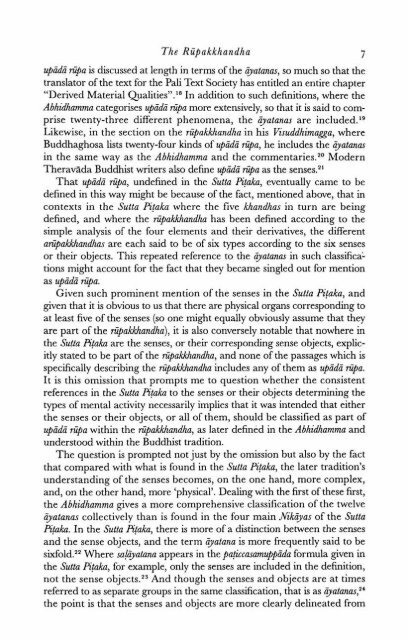Identity and Experience_Hamilton_1996
Identity and Experience_Hamilton_1996
Identity and Experience_Hamilton_1996
You also want an ePaper? Increase the reach of your titles
YUMPU automatically turns print PDFs into web optimized ePapers that Google loves.
The Riipakkh<strong>and</strong>ha 7<br />
upad5 nipa is discussed at length in terms of the qatanas, so much so that the<br />
translator of the text for the Pali Text Society has entitled an entire chapter<br />
"Derived Material Qualitie~".'~ In addition to such definitions, where the<br />
Abhidhamma categorises upid6 nipa more extensively, so that it is said to comprise<br />
twenty-three different phenomena, the gatanas are included.lg<br />
Likewise, in the section on the riipakkh<strong>and</strong>ha in his fisuddhimagga, where<br />
Buddhaghosa lists twenty-four kinds of upidi riipa, he includes the &atanus<br />
in the same way as the Abhidhamma <strong>and</strong> the c~mmentaries.~~ Modern<br />
Theravada Buddhist writers also define upzdi Spa as the senses.21<br />
That u.Jdi riipa, undefined in the Sutta Pitaka, eventually came to be<br />
defined in this way might be because of the fact, mentioned above, that in<br />
contexts in the Sutta Pitaka where the five kh<strong>and</strong>has in turn are being<br />
defined, <strong>and</strong> where the nipakkh<strong>and</strong>ha has been defined according to the<br />
simple analysis of the four elements <strong>and</strong> their derivatives, the different<br />
anipaWd2<strong>and</strong>ha-s are each said to be of six types according to the six senses<br />
or their objects. This repeated reference to the @atanas in such classifica~<br />
tions might account for the fact that they became singled out for mention<br />
as upEdi riipa.<br />
Given such prominent mention of the senses in the Sutta Pitaka, <strong>and</strong><br />
given that it is obvious to us that there are physical organs corresponding to<br />
at least five of the senses (so one might equally obviously assume that they<br />
are part of the ru'pakkh<strong>and</strong>ha), it is also conversely notable that nowhere in<br />
the Sutta Pitaka are the senses, or their corresponding sense objects, explicitly<br />
stated to be part of the riipakkh<strong>and</strong>ha, <strong>and</strong> none of the passages which is<br />
specifically describing the riipakkh<strong>and</strong>ha includes any of them as upEdd nipa.<br />
It is this omission that prompts me to question whether the consistent<br />
references in the Sutta Pitaka to the senses or their objects determining the<br />
types of mental activity necessarily implies that it was intended that either<br />
the senses or their objects, or all of them, should be classified as part of<br />
upid5 nipa within the ru'pakkh<strong>and</strong>ha, as later defined in the Abhidhamma <strong>and</strong><br />
understood within the Buddhist tradition.<br />
The question is prompted not just by the omission but also by the fact<br />
that compared with what is found in the Sutta P&ka, the later tradition's<br />
underst<strong>and</strong>ing of the senses becomes, on the one h<strong>and</strong>, more complex,<br />
<strong>and</strong>, on the other h<strong>and</strong>, more 'physical'. Dealing with the first of these first,<br />
the Abhidhamma gives a more comprehensive classification of the twelve<br />
Zyatanas collectively than is found in the four main NikZyas of the Sutta<br />
&taka. In the Sutta Pi!aka, there is more of a distinction between the senses<br />
<strong>and</strong> the sense objects, <strong>and</strong> the term Qatana is more frequently said to be<br />
sixfold.** Where sabyatana appears in the pa$ccasamuppida formula given in<br />
the Sutta Pitaka, for example, only the senses are included in the definition,<br />
not the sense objects.13 And though the senses <strong>and</strong> objects are at times<br />
referred to as separate groups in the same classification, that is as dyatana.~,~~<br />
the point is that the senses <strong>and</strong> objects are more clearly delineated from


